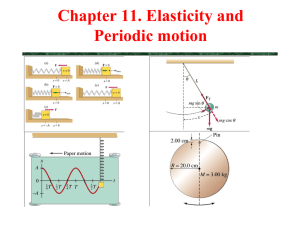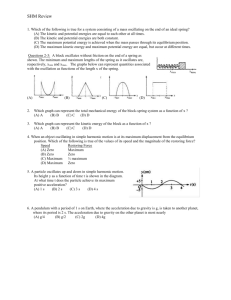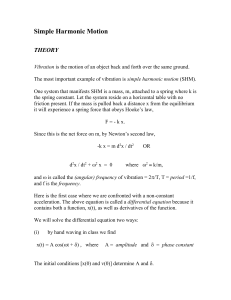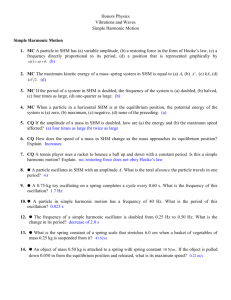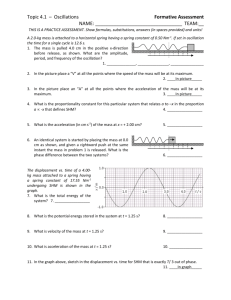Linux Interprocess Communications
advertisement
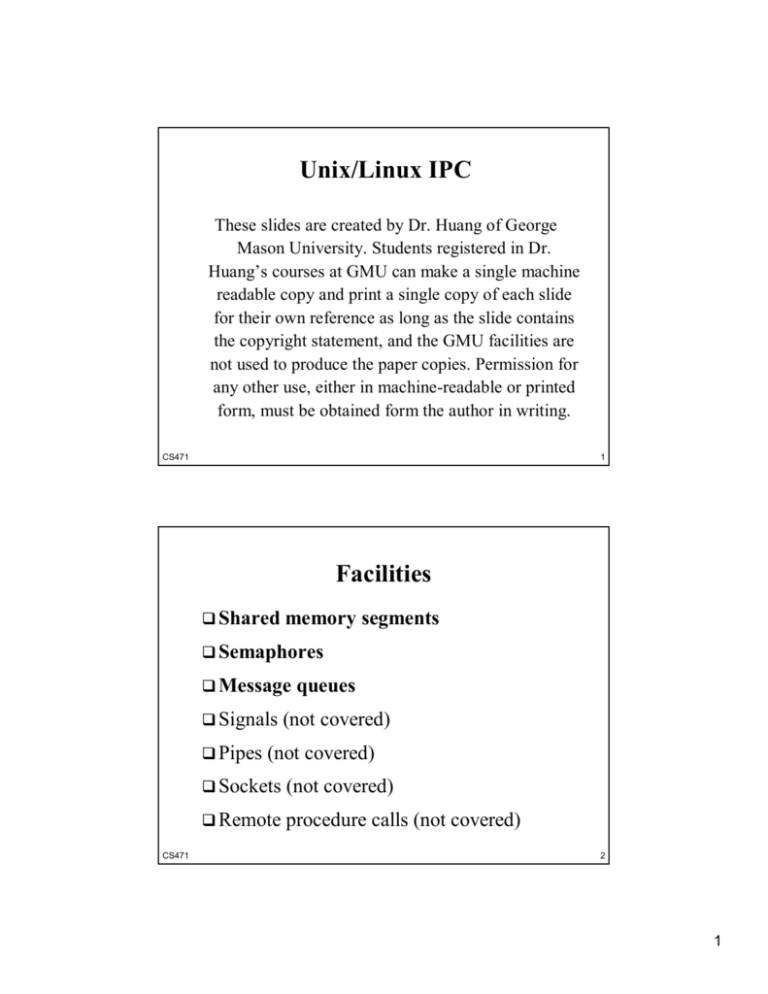
Unix/Linux IPC
These slides are created by Dr. Huang of George
Mason University. Students registered in Dr.
Huang’s courses at GMU can make a single machine
readable copy and print a single copy of each slide
for their own reference as long as the slide contains
the copyright statement, and the GMU facilities are
not used to produce the paper copies. Permission for
any other use, either in machine-readable or printed
form, must be obtained form the author in writing.
CS471
1
Facilities
Shared memory segments
Semaphores
Message queues
Signals (not covered)
Pipes (not covered)
Sockets (not covered)
Remote procedure calls (not covered)
CS471
2
1
Shared Memory Segments
Mmap()-ed areas survives fork() but not
exec().
Shared memory segments in the contrary can
be accessed by any process
– not limited to parent-child processes
– Permissions can be set to determine who has
what access to it
Following programming conventions, we will
call a shared memory segment an shm.
Each shm has a system-wide unique ID.
CS471
3
Shm Operations
shmget()
– Creating new shm
– Obtaining the ID of an existing shm
shmat(): attach an shm as an VM area
shmdt(): detach an shm
shmctl():
– Read/modify permssions, owners etc.
– Destroy shm
CS471
4
2
shmget()
int shmget (int shm_key, int size,
int shm_flags);
shm_key: a system-wide unique key for the
shm
size: # of bytes of the segments
shm_flags: the bit-OR of the following
– SHM_CREAT
– mode (0666=all can read and write, …)
Returns the ID of the shm
CS471
5
shmat()
void* shmat (int shm_id,
void* shmaddr,
int flags);
shmaddr: recommended address of the shm in
the virtual memory space of the calling process
– NULL means no recommendation
flags:
– 0, read/write
– SHM_RDONLY
Returns the starting address of the new area
CS471
6
3
shmdt()
int shmdt (void* shmaddr);
shmaddr: the address of the shm (in the VM of
the calling process) to be detached.
Returns 0 when successful
Detachment does NOT destroy an shm.
CS471
7
Destroy Shm
shmctl (shm_id, IPC_RMID, NULL);
This only marks the shm for destroying.
The shm is destroyed when the last process
detaches it.
CS471
8
4
Creating A New Shm
shm_id = shmget (4567, 4096,
IPC_CREAT | 0600);
shm_ptr = shmat (shm_id, 0, 0);
It is your responsibility to make sure 4567 is a
unique key on the system.
The new area will survive fork() but not
exec().
CS471
9
Using An Existing Shm by A
Different Process
shm_id = shmget (4567, 4096, 0600);
shm_ptr = shmat (shm_id, 0, 0);
Notice the use of the same key, 4567.
Notice the absence of IPC_Creat in
shmget(). This causes the system to look for
an already-present shm, rather than creating a
new one.
CS471
10
5
Finding Shm Keys
Ensuring a key is system-wide unique can be a
problem in multi-user environments.
The ftok() function helps find such a key.
– This is a library function, not a system call.
int ftok (char* pathname, int id);
– pathname: the name of an arbitrary file.
– id: for further distinction.
– Returns a key that is “very likely” unique.
CS471
11
Semaphores
A semaphore in Unix/Linux is a special
purpose shm.
Share the same key space with shm.
A semaphore ID is associated with a set of
atomic semaphores.
CS471
12
6
Semget()
int semget (int sem_key, int nsem,
int semflg)
sem_key: system-wide semaphore key
nsem: number of semaphores in the set
smgflg: the bit-OR of the following
– IPC_CREAT
– mode (0666=all can read and write, …)
Returns the ID of the semaphore set.
CS471
13
Example
Producer creates new semaphore with key
1234 by
sem_id = semget (1234, 1,
IPC_CREAT | 0666);
Consumer obtains that semaphore by
sem_id = semget (1234, 1, 0);
CS471
14
7
Semctl()
semctl (sem_id, i, GETVAL);
– returns the value of the i-th semaphore in the
set sem_id.
semctl (sem_id, 0, IPC_RMID);
– destroys the semaphore set sem_id.
See its man page for other functions.
CS471
15
Semop()
int semop (sem_id,
struct sembuf *sops,
int nops)
sem_id: semaphore set ID
sops: an array of semaphore operations,
performed atomically
nops: # of operations in sops
Returns 0 when successful, or else -1.
CS471
16
8
Struct sembuf
Each operation is described by a sembuf
structure, including the following membors
– sem_flg: 0 in most situations
– sem_num: give the semaphore to which this
operation is applied. The first semaphore in
a set is numbered 0.
– sem_op: see next page
CS471
17
Sem_op
Greater than 0
– Semaphore value += sem_op
– Calling process proceeds immediately
Equal to 0
– Calling process waits until the value of the
semaphore becomes 0
Less than 0
– Calling process waits until
semaphore value + sem_op >= 0
– Semaphore value += sem_op
CS471
18
9
Message Queues
int msgget (int msg_key, int flags)
msg_key: system-wide semaphore key; the
same key space with shm.
flags: the bit-OR of the following
– IPC_CREAT
– mode (0666=all can read and write, …)
Returns the ID of the message queue.
CS471
19
Send Messages
int msgsnd (msg_id, void* msg_ptr,
int msize, int flags)
msg_id: message queue ID
msg_ptr: a pointer to the message, which must
follow the format
struct msg_type {
long mtype; /* message type */
Other members determined by the app.
}
msize: message size in bytes, excluding mtype
flags: 0 in most situations
Returns 0 when successful, or else -1.
CS471
20
10
Receive Messages
int msgrcv (msg_id, void* msg_ptr,
int msize,
int mtype, int flags)
msg_id: message queue ID
msg_ptr: a pointer to the message.
msize: message size in bytes, excluding mtype
mtype: retrieve from the queue the first
message with the given type
flags: 0 in most situations
Returns 0 when successful, or else -1.
CS471
21
Message Formats
struct command_msg
{
long mtype;
char cmd;
int n;
};
CS471
struct result_msg
{
long mtype;
int result;
};
22
11
Foreground
int main ()
{
/* obvious variable declarations omitted */
int cmd_q, result_q; /* message queue Ids */
struct command_msg c_msg;
struct result_msg r_msg;
c_msg.mtype = 1;
cmd_q = msgget (47103, IPC_CREAT | 0600);
result_q = msgget (47104, IPC_CREAT | 0600);
CS471
23
if (!(pid=fork()))
execl ("backg", "backg", NULL);
while (1) {
scanf (" %c", &c_msg.cmd);
if (c_msg.cmd == 'q') {
msgsnd (cmd_q, &c_msg,
sizeof c_msg - sizeof c_msg.mtype , 0);
wait(0);
msgctl (cmd_q, IPC_RMID, NULL);
msgctl (result_q, IPC_RMID, NULL);
exit(0);
} /* end of command ‘q’ */
CS471
24
12
/* Handle ‘s’ and ‘f’ commands */
scanf ("%d", &c_msg.n);
msgsnd (cmd_q, &c_msg,
sizeof c_msg - sizeof c_msg.mtype , 0);
msgrcv (result_q, &r_msg,
sizeof r_msg.result, 1, 0);
printf ("Result = %d\n", r_msg.result);
} /* end of while (1) */
} /* end of main() */
CS471
25
Background
int main ()
{
/* obvious variable declarations omitted */
int cmd_q, result_q; /* message queue Ids */
struct command_msg c_msg;
struct result_msg r_msg;
r_msg.mtype = 1;
cmd_q = msgget (47103, 0);
result_q = msgget (47104, 0);
CS471
26
13
while (1) {
msgrcv (cmd_q, &c_msg,
sizeof c_msg - sizeof c_msg.mtype, 1, 0);
switch (c_msg.cmd) {
case 's':
for (sum=i=0; i<=c_msg.n; i++) sum+=i;
r_msg.result = sum;
break;
case 'f': /* details omitted */
case 'q': exit(0);
} /* end of switch() */
msgsnd (result_q, &r_msg, sizeof r_msg.result , 0);
} /* end of while (1) */
CS471
27
Project #3
Redo project #2 using semaphores and shm.
Due midnight of July 23rd
CS471
28
14
Foreground Process
Accept the same commands as project #2.
Communicate with background through shm.
– Use ftok() to generate shm_key
– Use your home directory as the pathname
and character ‘m’ as the ID.
Use semaphores for synchronization.
– Use ftok() to generate sem_key
– Use your home directory as the pathname.
– Use IDs ‘1’, ‘2’, ‘3’ …
Destroy shm and semaphores when terminates
CS471
29
Foreground Logic
Print own process ID
Creates shm and semaphores
Attach shm
Execute the following in a loop
– Wait for user command
– Semaphore-signal background process for
the readiness of the command and operand
– Semaphore-wait for result
– Print result
Destroy shm and semaphores
CS471
30
15
Background Process
Perform the computations of summation and
factorial.
Use shm and semaphores for communications
and synchronizations.
Semaphore and shm keys are obtained through
command line arguments:
– backg shm_key sem_key1 sem_key2
Terminate itself when seeing the Q/q
command.
Detach the shm when terminates.
CS471
31
Background Logic
Print own process ID
Obtain shm and semaphores
Attach shm
Execute the following in a loop
– Semaphore-wait for user command
– Perform computations
– Semaphore-signal the foreground for the
readiness of the result.
Detach shm
CS471
32
16
